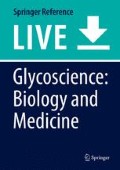Abstract
Sea urchins have been excellent model systems to study the molecular mechanisms of fertilization. The sperm acrosome reaction (AR), a necessary process for penetrating the extracellular matrix of the egg, binding to the egg surface, and fusing with the egg plasma membrane, has been a central issue in research into sperm–egg interactions. Unambiguously, sea urchin spermatozoa trigger the AR upon contact with the thick gelatinous layer (egg jelly) surrounding the egg. The inducer of the sperm AR is a pure polysaccharide composed of fucose and sulfate groups with no other detectable sugars or amino acids. Structural analysis of this compound has revealed an unbranched chain of α-l-fucopyranose (FSP) molecules with an α1-3 glycosidic link and O-sulfates at the C-2 and/or C-4 position, giving a tandem repeat of sulfated saccharides with an apparent molecular mass of over one million daltons. Studies have revealed species-unique structural, but limited, diversification within the monosaccharide composition, glycosidic links, and modification by sulfates. Species-specific or species-preferential induction of the sperm AR is well explained by differences or similarities in the arrangements of sulfated polysaccharides. Another polysaccharide found in egg jelly is a sialic acid composed of poly N-glycolylneuraminic acid (polyNeuGc). PolyNeuGc itself does not induce the AR; however, if FSP is present, it greatly potentiates biological activity independent of FSP signaling. The receptor for polyNeuGc on sea urchin spermatozoa has never been identified. There are many unanswered questions regarding carbohydrate-based sperm–egg recognition in sea urchins that – if answered – could offer insights into the fields of glycobiology, reproduction, and evolution.
References
Alves AP, Mulloy B, Moy GW, Vacquier VD, Mourão PA (1998) Females of the sea urchin Strongylocentrotus purpuratus differ in the structures of their egg jelly sulfated fucans. Glycobiology 8:939–946
Cinelli LP, Andrade L, Valente AP, Mourão PA (2010) Sulfated alpha-l-galactans from the sea urchin ovary: selective 6-desulfation as eggs are spawned. Glycobiology 20:702–709
Hirohashi N, Vacquier VD (2002a) High molecular mass egg fucose sulfate polymer is required for opening both Ca2+ channels involved in triggering the sea urchin sperm acrosome reaction. J Biol Chem 277:1182–1189
Hirohashi N, Vacquier VD (2002b) Egg sialoglycans increase intracellular pH and potentiate the acrosome reaction of sea urchin sperm. J Biol Chem 277:8041–8047
Hirohashi N, Vacquier VD (2003) Store-operated calcium channels trigger exocytosis of the sea urchin sperm acrosomal vesicle. Biochem Biophys Res Commun 304:285–292
Hirohashi N, Vilela-Silva AC, Mourão PA, Vacquier VD (2002) Structural requirements for species-specific induction of the sperm acrosome reaction by sea urchin egg sulfated fucan. Biochem Biophys Res Commun 298:403–407
Kamei N, Glabe CG (2003) The species-specific egg receptor for sea urchin sperm adhesion is EBR1, a novel ADAMTS protein. Genes Dev 17:2502–2507
Kitazume S, Kitajima K, Inoue S, Troy FA 2nd, Cho JW, Lennarz WJ, Inoue Y (1994) Identification of polysialic acid-containing glycoprotein in the jelly coat of sea urchin eggs. Occurrence of a novel type of polysialic acid structure. J Biol Chem 269:22712–22718
Mulloy B, Ribeiro AC, Alves AP, Vieira RP, Mourão PA (1994) Sulfated fucans from echinoderms have a regular tetrasaccharide repeating unit defined by specific patterns of sulfation at the O-2 and O-4 positions. J Biol Chem 269:22113–22123
Nakano E, Ohashi S (1954) On the carbohydrate component of the jelly coat and related substances of eggs from japanese sea urchins. Embryologia 2:81–85
Nixon B, Lu Q, Wassler MJ, Foote CI, Ensslin MA, Shur BD (2001) Galactosyltransferase function during mammalian fertilization. Cells Tissues Organs 168:46–57
SeGall GK, Lennarz WJ (1979) Chemical characterization of the component of the jelly coat from sea urchin eggs responsible for induction of the acrosome reaction. Dev Biol 71:33–48
Vacquier VD (2012) The quest for the sea urchin egg receptor for sperm. Biochem Biophys Res Commun 425:583–587
Vacquier VD, Moy GW (1997) The fucose sulfate polymer of egg jelly binds to sperm REJ and is the inducer of the sea urchin sperm acrosome reaction. Dev Biol 192:125–135
Vasseur E (1948) Chemical studies on the jelly coat of the sea-urchin egg. Acta Chem Scand 2:900–913
Vasseur E, Immers J (1949) Genus specificity of the carbohydrate component in the sea-urchin egg jelly coat as revealed by paper chromatography. Ark Kemi 1:39–41
Vilela-Silva AC, Alves AP, Valente AP, Vacquier VD, Mourão PA (1999) Structure of the sulfated alpha-l-fucan from the egg jelly coat of the sea urchin Strongylocentrotus franciscanus: patterns of preferential 2-O- and 4-O-sulfation determine sperm cell recognition. Glycobiology 9:927–933
Yamakawa N, Sato C, Miyata S, Maehashi E, Toriyama M, Sato N, Furuhata K, Kitajima K (2007) Development of sensitive chemical and immunochemical methods for detecting sulfated sialic acids and their application to glycoconjugates from sea urchin sperm and eggs. Biochimie 89:1396–1408
Author information
Authors and Affiliations
Corresponding author
Editor information
Editors and Affiliations
Rights and permissions
Copyright information
© 2014 Springer Japan
About this entry
Cite this entry
Hirohashi, N. (2014). Carbohydrate-Based Gamete Recognition During the Sperm Acrosome Reaction in Sea Urchins. In: Endo, T., Seeberger, P., Hart, G., Wong, CH., Taniguchi, N. (eds) Glycoscience: Biology and Medicine. Springer, Tokyo. https://doi.org/10.1007/978-4-431-54836-2_166-1
Download citation
DOI: https://doi.org/10.1007/978-4-431-54836-2_166-1
Received:
Accepted:
Published:
Publisher Name: Springer, Tokyo
Online ISBN: 978-4-431-54836-2
eBook Packages: Springer Reference Biomedicine and Life SciencesReference Module Biomedical and Life Sciences

